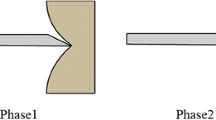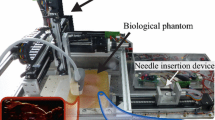Abstract
Purpose
This paper proposes a method to predict the deflection of a flexible needle inserted into soft tissue based on the observation of deflection at a single point along the needle shaft.
Methods
We model the needle-tissue as a discretized structure composed of several virtual, weightless, rigid links connected by virtual helical springs whose stiffness coefficient is found using a pattern search algorithm that only requires the force applied at the needle tip during insertion and the needle deflection measured at an arbitrary insertion depth. Needle tip deflections can then be predicted for different insertion depths.
Results
Verification of the proposed method in synthetic and biological tissue shows a deflection estimation error of \(<\)2 mm for images acquired at 35 % or more of the maximum insertion depth, and decreases to 1 mm for images acquired closer to the final insertion depth. We also demonstrate the utility of the model for prostate brachytherapy, where in vivo needle deflection measurements obtained during early stages of insertion are used to predict the needle deflection further along the insertion process.
Conclusion
The method can predict needle deflection based on the observation of deflection at a single point. The ultrasound probe can be maintained at the same position during insertion of the needle, which avoids complications of tissue deformation caused by the motion of the ultrasound probe.













Similar content being viewed by others
References
Abayazid M, Roesthuis R, Reilink R, Misra S (2013) Integrating deflection models and image feedback for real-time flexible needle steering. Robot IEEE Trans 29(2):542–553
Abolhassani N, Patel R, Ayazi F (2007) Needle control along desired tracks in robotic prostate brachytherapy. In: IEEE international conference on systems, man and cybernetics, 2007, ISIC, pp 3361–3366. IEEE
Beer FP, Sanghi S (2012) Mechanics of materials, 6th edn. McGraw-Hill, New York (global ed./adapted by Sanjeev Sanghi edn., includes index)
Bogdanich W (2009) At VA hospital, a rogue cancer unit. The New York Times, New York
Chapman GA, Johnson D, Bodenham AR (2006) Visualisation of needle position using ultrasonography. Anaesthesia 61(2):148–158. doi:10.1111/j.1365-2044.2005.04475.x
Chin KJ, Perlas A, Chan VW, Brull R (2008) Needle visualization in ultrasound-guided regional anesthesia: challenges and solutions. Reg Anesth Pain Med 33(6):532–544
Dehghan E, Goksel O, Salcudean SE (2006) A comparison of needle bending models. In: Medical image computing and computer-assisted intervention–MICCAI 2006, pp 305–312. Springer
Fischler MA, Bolles RC (1981) Random sample consensus: a paradigm for model fitting with applications to image analysis and automated cartography. Commun ACM 24(6):381–395
Glozman D, Shoham M (2007) Image-guided robotic flexible needle steering. Robot IEEE Trans 23(3):459–467. doi:10.1109/TRO.2007.898972
Goksel O, Dehghan E, Salcudean SE (2009) Modeling and simulation of flexible needles. Med Eng Phys 31(9):1069–1078
Gonzales RC, Woods RE (2002) Digital image processing, 2nd edn. Prentice Hall, Upper Saddle River
Haddadi A, Hashtrudi-Zaad K (2011) Development of a dynamic model for bevel-tip flexible needle insertion into soft tissues. In: 2011 annual international conference of the IEEE, engineering in medicine and biology society, EMBC, pp 7478–7482. IEEE
Hong J, Dohi T, Hashizume M, Konishi K, Hata N (2004) An ultrasound-driven needle-insertion robot for percutaneous cholecystostomy. Phys Med Biol 49(3):441
Khadem M, Fallahi B, Rossa C, Sloboda R, Usmani N, Tavakoli M (2015) A mechanics-based model for simulation and control of flexible needle insertion in soft tissue. In: 2015 IEEE international conference on, robotics and automation (ICRA), pp 2264–2269
Krouskop TA, Wheeler TM, Kallel F, Garra BS, Hall T (1998) Elastic moduli of breast and prostate tissues under compression. Ultrason Imaging 20(4):260–274
Lachaine M, Falco T (2013) Intrafractional prostate motion management with the clarity autoscan system. Med Phys Int 1(1):72–80
Lehmann T, Rossa C, Usmani N, Sloboda R, Tavakoli M (2015) A virtual sensor for needle deflection estimation during soft-tissue needle insertion. In: 2015 IEEE international conference on, robotics and automation (ICRA), pp 1217–1222
Mathiassen K, Dall’Alba D, Muradore R, Fiorini P, Elle OJ (2013) Real-time biopsy needle tip estimation in 2d ultrasound images. In: 2013 IEEE international conference on, robotics and automation (ICRA), pp 4363–4369. IEEE
Misra S, Reed K, Schafer B, Ramesh K, Okamura A (2010) Mechanics of flexible needles robotically steered through soft tissue. Int J Robot Res 29(13):1640–1660. doi:10.1177/0278364910369714
Moreira P, Misra S (2014) Biomechanics-based curvature estimation for ultrasound-guided flexible needle steering in biological tissues. Ann Biomed Eng. doi:10.1007/s10439-014-1203-5
Nag S, Bice W, DeWyngaert K, Prestidge B, Stock R, Yu Y (2000) The american brachytherapy society recommendations for permanent prostate brachytherapy postimplant dosimetric analysis. Int J Radiat Oncol Biol Phys 46(1):221–230
Neubach Z, Shoham M (2010) Ultrasound-guided robot for flexible needle steering. Biomed Eng IEEE Trans 57(4):799–805
Okamura A, Simone C, O’Leary M (2004) Force modeling for needle insertion into soft tissue. IEEE Trans Biomed Eng 51(10):1707–1716. doi:10.1109/TBME.2004.831542
Okazawa SH, Ebrahimi R, Chuang J, Rohling RN, Salcudean SE (2006) Methods for segmenting curved needles in ultrasound images. Med Image Anal 10(3):330–342
Schlosser J, Salisbury K, Hristov D (2011) We-d-220-01: tissue displacement monitoring for prostate and liver igrt using a robotically-controlled ultrasound system. Med Phys 38(6):3812–3812
Spong MW, Vidyasagar M (2008) Robot dynamics and control. Wiley, Hoboken
Vrooijink GJ, Abayazid M, Patil S, Alterovitz R, Misra S (2014) Needle path planning and steering in a three-dimensional non-static environment using two-dimensional ultrasound images. Int J Robot Res 33(10): 0278364914526627
Waine M, Rossa C, Sloboda R, Usmani N, Tavakoli M (2015) 3D shape visualization of curved needles in tissue from 2D ultrasound images using ransac. In: 2015 IEEE international conference on, robotics and automation, pp 4723–4728. IEEE
Yan P, Cheeseborough JC, Chao KC (2012) Automatic shape-based level set segmentation for needle tracking in 3-d trus-guided prostate brachytherapy. Ultrasound Med Biol 38(9):1626–1636
Author information
Authors and Affiliations
Corresponding author
Ethics declarations
Conflict of interest
The authors declare that they have no conflict of interest.
Ethical standard
All procedures performed in studies involving human participants were in accordance with the ethical standards of the institutional and/or national research committee and with the 1964 Helsinki declaration and its later amendments or comparable ethical standards.
Informed consent
Informed consent was obtained from all individual participants included in the study. Approval for the study granted by the Alberta Cancer Research Ethics Committee under file number 25837.
Additional information
This work was supported by the Natural Sciences and Engineering Research Council (NSERC) of Canada under grant CHRP 446520, the Canadian Institutes of Health Research (CIHR) under Grant CPG 127768, and by the Alberta Innovates Health Solutions (AIHS) under Grant CRIO 201201232.
Rights and permissions
About this article
Cite this article
Rossa, C., Sloboda, R., Usmani, N. et al. Estimating needle tip deflection in biological tissue from a single transverse ultrasound image: application to brachytherapy. Int J CARS 11, 1347–1359 (2016). https://doi.org/10.1007/s11548-015-1329-4
Received:
Accepted:
Published:
Issue Date:
DOI: https://doi.org/10.1007/s11548-015-1329-4




